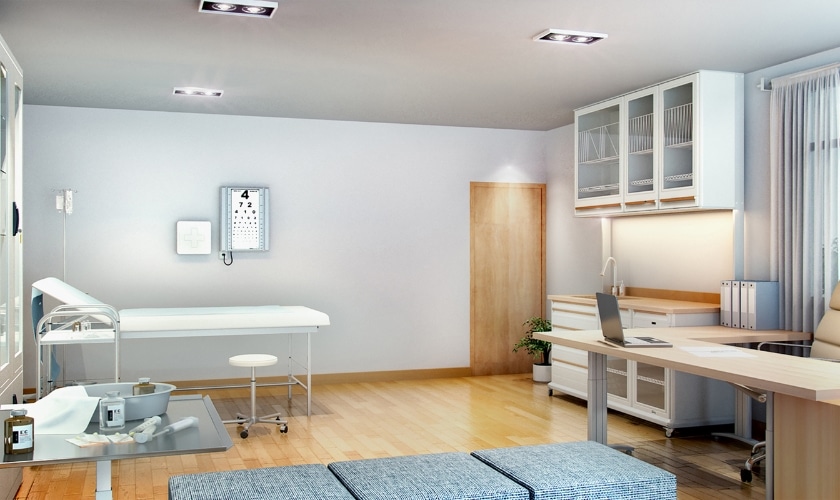
5 Innovative Design Ideas For A Modern Medical Office Construction
The traditional medical office – sterile, with white walls, uncomfortable chairs, and an overwhelming sense of clinical detachment – is quickly becoming a relic of the past. Modern medical office construction design prioritizes both functionality and patient experience, aiming to create an environment that is not only efficient but also welcoming and calming. This shift benefits not just patients seeking medical care, but also fosters a positive and productive work environment for staff.
If you’re considering revamping your existing medical office or embarking on a new construction project, here are 5 innovative design ideas to integrate into your plans:
1. Biophilic Design: Nature’s Calming Touch
Studies have consistently shown that incorporating elements of nature into a space can significantly reduce stress and anxiety. Biophilic design, a concept that emphasizes the inherent human connection to nature, can be a powerful tool in a medical setting.
- Harnessing Natural Light: Maximize the use of natural light by incorporating ample windows and skylights throughout the office. This not only brightens the space but also provides a connection to the outdoors, fostering a sense of well-being.
- Indoor Oasis: Strategically placed plants can purify the air, reduce noise, and create a sense of calm. Opt for low-maintenance varieties like snake plants, spider plants, or ferns.
- Nature-Inspired Elements: Consider incorporating calming water features, natural textures like wood and stone, or calming color palettes that reflect the serenity of nature (think light blues, greens, and browns).
2. Tech-Savvy for a Streamlined Experience
Technology, when implemented thoughtfully, can significantly enhance the patient experience and improve operational efficiency for your staff. Here are some innovative ways to leverage technology in your medical office:
- Self-Service Kiosks: Empower patients to check in, update information, and even schedule appointments through user-friendly kiosks. This frees up valuable staff time and reduces wait times.
- Digital Signage: Utilize digital displays in the waiting area to share appointment wait times, display patient education videos, or disseminate important health tips.
- Telemedicine Integration: Offer telemedicine appointments for patients who prefer the convenience of remote consultations. This can be particularly beneficial for follow-up appointments or consultations for non-critical issues.
- Interactive Waiting Room: Consider providing interactive touchscreens or tablets for patients to access educational materials, play games, or complete surveys during their wait time.
3. A Flexible and Functional Flow
A well-designed layout optimizes workflow for staff and creates a comfortable experience for patients. Here are some key considerations for creating a functional flow:
- Open Yet Defined: Aim for an open floor plan that feels airy and inviting while still offering designated areas for waiting, consultations, and examinations. Movable partitions can further enhance flexibility and create a sense of privacy when needed.
- Multi-Purpose Rooms: Design exam rooms that can be easily adapted for different specialties or procedures. This maximizes space utilization and reduces the need for dedicated rooms for specific uses.
- Accessibility for All: Ensure your office is accessible for patients with disabilities. This includes incorporating ramps, wider doorways, and grab bars in restrooms to create an inclusive environment.
4. Sensory Comfort and Clear Navigation
Thoughtful design choices that address sensory comfort and wayfinding can create a more calming and patient-centered environment:
- Lighting Control: Utilize a combination of natural and adjustable artificial lighting to create warm and inviting spaces. Consider dimmable lights for exam rooms to create a more relaxing atmosphere during consultations.
- Sound Management: Incorporate soundproofing materials in walls and ceilings to minimize noise distractions and create a sense of tranquility.
- Intuitive Wayfinding: Use clear signage and visual cues to guide patients through your office. This reduces confusion and stress, especially for first-time visitors. Consider color-coding different areas or using easily identifiable landmarks to aid navigation.
5. Prioritizing Patient Privacy and Security
Maintaining patient privacy and data security is paramount in any medical setting. Here are some design elements to consider:
- Private Consultations: Ensure exam rooms have soundproof doors and adequate space for confidential discussions.
- Secure Check-In Stations: Design reception areas with separate stations for check-in to protect patient information overheard by others.
- Cybersecurity Measures: Implement robust cybersecurity protocols and employee training to safeguard sensitive patient data.
By incorporating these medical office construction innovative design ideas, you can create a modern medical office that caters to both patient comfort and staff efficiency. Remember, a well-designed space can foster a sense of well-being for everyone who walks through the door, making the experience of visiting the doctor less stressful and more positive.
When implementing these design ideas, consider your target patient population and their specific needs. For instance, a pediatric office might incorporate vibrant colors and playful elements, while a geriatric practice might prioritize wider hallways and comfortable seating options.
By creating a welcoming and innovative space, you can position your medical office as a leader in patient-centered care.

